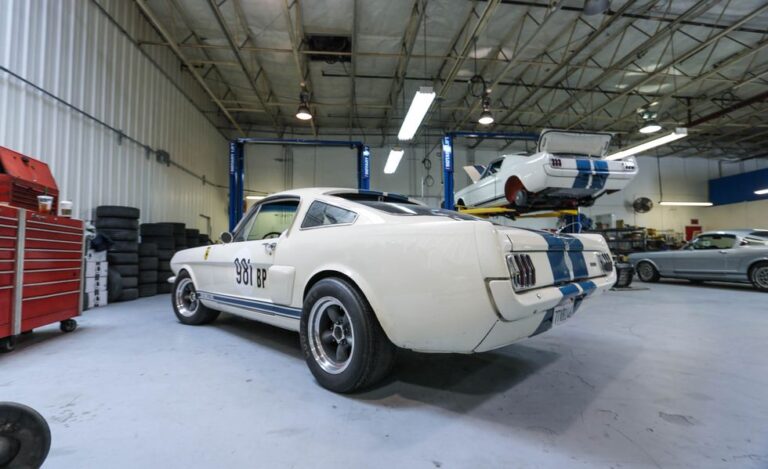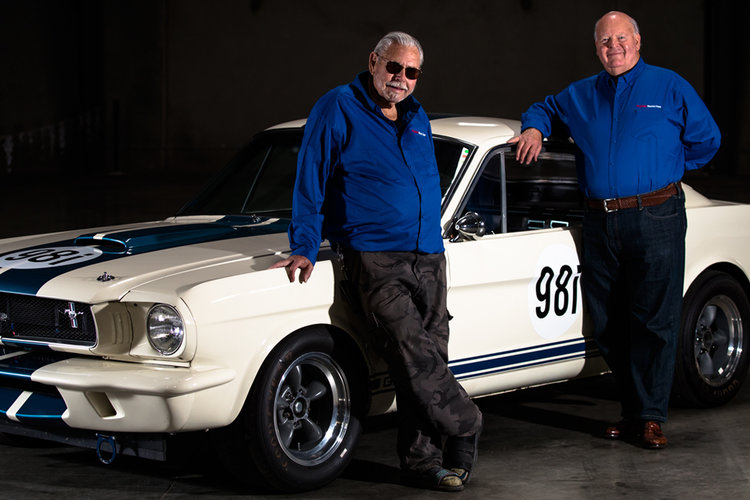1965 OVC SHELBY MUSTANG GT350R CONTINUATION SERIES
Few cars are as steeped in 1960s car culture nostalgia as the 1965 Shelby Mustang GT350 Competition, aka the GT350R. The Shelby-modified Ford Mustang won race after SCCA Class B race on its very first outing, legitimising Mustang performance.
The people who know best are the ones who built the original models. And they’re here, too. Better yet, some of them have banded together to form the l’Original Venice Crew (OVC) Mustangs – Peter Brock, Ted Sutton, Jim Marietta and Duane Carling, to build a continuation series of 36 more 1965 Shelby Mustang GT350 Competition cars.
The idea
Jim Marietta was just 17 years old on January 2, 1965, when he began working on GT350Rs as a mechanic in Shelby American’s Venice, California, shop. He says it was in late 2013 that the “steady stream of ideas and thoughts” about building an additional GT350R began. First at a Shelby alumni meeting, then at the annual SEMA party hosted by legendary racer and car designer Peter Brock (who notably led the various modifications to the original GT350R). Jim Marietta eventually asked Peter Brock and Venice team mechanic Ted Sutton to turn another “K-code” Mustang GT fastback, with its 271-horsepower 289 CI HiPo engine and four-speed manual transmission, into a GT350R.
The job wouldn’t be easy, he thought, involving finding or fabricating everything needed to replicate the original’s body; stripping out the interior and installing the same rudimentary set of gauges, a vintage driver’s racing seat and the stock passenger seat; anchoring the spare wheel in place of the rear seat; adapting the engine to Shelby’s specifications; and painting the whole thing Wimbledon White with Guardsman Blue stripes.
“The original idea was to build it as close as possible to what we did 50 years ago, with the same people, and to make it run the same way,” says Jim Marietta. He hadn’t yet considered upgrading the GT350R, or building more than one. But another Mustang fan got wind of his plans, and soon the family grew.
The upgrades
Then Peter Brock stepped in. The original modifications to the 1965 GT350R are well known to Mustang fans and include hand-hammered rear fender flares to accommodate wider tyres, a fiberglass scoop and bonnet, simple rear quarter panels in place of the GT’s louvers, a “speed bump” plexiglass rear window that creates a slot under the roof for ventilation, and a front air intake “that makes it look like someone threw a brick through the nose of the car.” If it all looked a bit sloppy, it was because it was, in fact, unfinished.

According to Jim Marietta, much of Peter Brock’s work on the GT350R was left on the drawing board when the Shelby shop moved from Venice to El Segundo while Brock was in Italy on another Shelby assignment. “Peter said to me, ‘You know, I had all this on my drawing board… and when I came back, the car was so far along that nobody wanted to change it,'” recalls Jim Marietta.
With the original GT350R designer offering to finish what he started, showing the world what he wanted the car to look like from the beginning, Marietta decided that some of the elements that were not included in the original GT350R could be done, provided they were in development at the time.
The main change is the rear window. While the original’s bumpy plexiglass rear window helped ventilate the cabin, it severely distorted the view to the rear. It also looked funny. Peter said: “If it had come back from the workshop in that condition, I would have sent it back. That’s not how I designed it. Jim Marietta shows off his car’s new rear window, which is both flatter and set at a flatter angle. “This is what Peter Brock envisioned in 1965.”
Peter Brock also reincorporated a front bumper through this gaping maw, simultaneously giving the nose a more finished look and better targeting airflow to specific engine components, according to Jim Marietta. The circular holes in the original bumper were transformed into vertical slots to direct cooling air to the front brakes via new metal ducts. Body-cut side scoops behind the doors perform the same function for the rear brakes via their own ducts. The rear quarter windows, which would not have been ready in time for the GT350R’s first outing, have found their place this time.
The engine
At the time, the Shelby GT350’s 289 V8 made 306 horsepower, and the GT350R increased that to 360. That was a lot of power at the time, but it’s not surprising that OVC wanted more. Specifically, it uses a Shelby Race Engines cast iron block engine that is essentially the same 289 that powered the K Code. The upgrades themselves are different and include electronic ignition, aluminum heads, a racing camshaft, and a “stroker” crankshaft that increases the displacement from 289 to about 331 CI.
This 289 IC produces 460 horsepower, accompanied by 420 lb-ft of torque in a car that weighs less than 1,300 kilograms.
“These modifications are a normal progression that more than likely would have also progressed in Shelby’s race shop,” says Jim Marietta, affirming the car’s authenticity despite the power increase.
Purists may scoff, but given that the OVC still uses a Shelby engine based on the 289, we’re not too worried. After all, race cars are often works in progress, and drivers are always experimenting with new components.

L’IRS (Independant Rear Suspension)
Jim Marietta lifts his car onto the deck, showing the most important mechanical upgrade of all – an independent rear suspension (IRS) that had been planned for the original Mustang, but would have been shelved before completion due to production cost issues. Peter Brock and Jim Marietta felt that they could also install the independent rear suspension on the car and complete the job.
Initially, these independent rear suspensions were designed for the AC COBRA 427 and Ford GT40 by Ford engineer Klaus Arning.

According to Jim Marietta, the original rear suspension was designed for ordinary road use, leaving the car generally prone to understeer and making the ride “a bit temperamental. Jim Marietta and the OVC team have completed the engineering work left undone 50 years ago. “Now the handling is neutral,” he said. “Once we did that, everyone thought it was great.”
Both Mustangs made their debuts at an event hosted by the Los Angeles Shelby American Automobile Club (LASAAC) in early 2015 to celebrate the 50th anniversary of the GT350’s first race win at Green Valley Raceway in Texas. Both “new” GT350Rs were numbered 98 in tribute to Ken Miles’ winning GT350R. Jim Marietta’s car was renamed 98i in reference to its independent rear suspension.
In the end, the IRS-equipped version is one second faster on the big Willow Springs track. Willow Springs is the same place where OVC tests and verifies every car it builds, just as Shelby did with the original GT350 50 years ago.
“Producing these cars is about maintaining the legacy of that era,” explains Jim Marietta. “It’s about recapturing as much of that feeling as possible and passing it on.”



